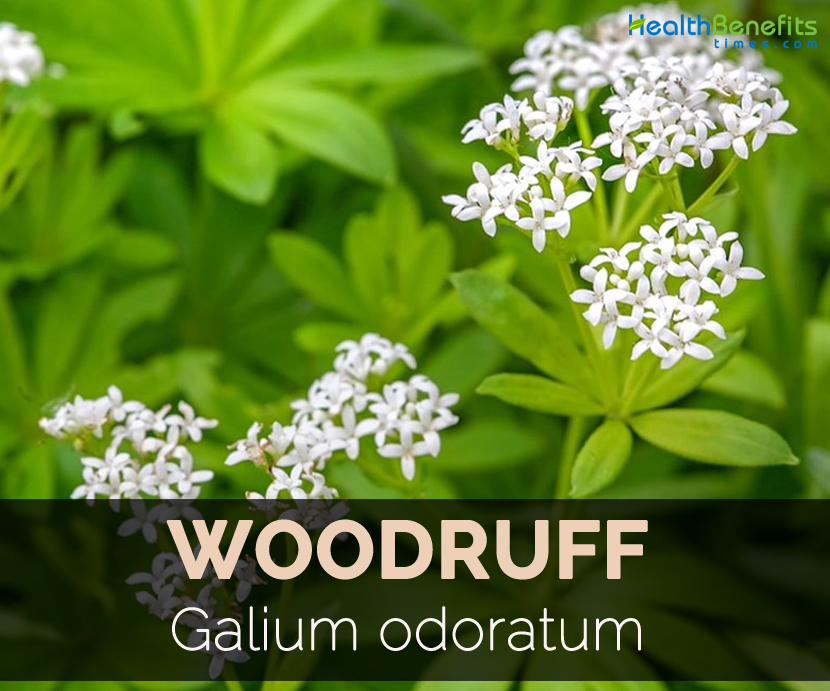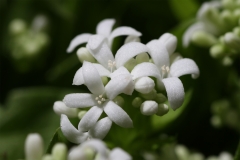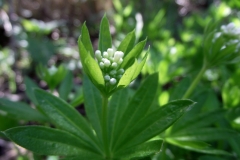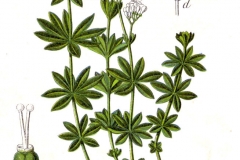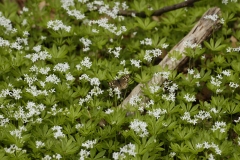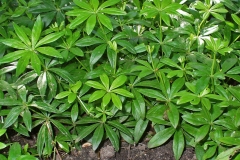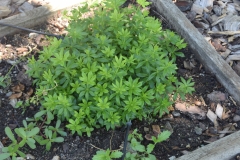| Woodruff Quick Facts | |
|---|---|
| Name: | Woodruff |
| Scientific Name: | Galium odoratum |
| Origin | Native to much of Europe from Spain and Ireland to Russia, as well as Western Siberia, Turkey, Iran, the Caucasus, China and Japan |
| Shapes | 2–4 mm diameter, produced singly, and each is covered in tiny hooked bristles |
| Taste | Sweet |
| Health benefits | Beneficial for restlessness, insomnia, stomachache, migraine, neuralgia, bladder stones, cuts and wounds, Uterine Cramps, Menopause problems, Nervousness, Dropsy, Varicose Veins, Poor Digestion and Heart problems |
| Name | Woodruff |
|---|---|
| Scientific Name | Galium odoratum |
| Native | Europe from Spain and Ireland to Russia, as well as Western Siberia, Turkey, Iran, the Caucasus, China and Japan |
| Common Names | Sweet Woodruff, Sweet scented bedstraw, Bedstraw, master of the woods, waldmeister, woodward, woodruff, wild baby’s breath, hay plant, kiss-me-quick, mugwet, rockweed |
| Name in Other Languages | Afrikaans: Soet houtruffel Albanian: Druvar i ëmbël, ngjitëse Amharic: T’awila t’awila (ጣውላ ጣውላ) Arabic: Wawadarif alhuluwa (وودرف الحلو), jawaysiat eatira (جويسئة عطرة) Armenian: K’aghts’r p’aytanyut (քաղցր փայտանյութ), Getnastgh buravet (Գետնաստղ բուրավետ) Azb: عطیرلی چتیریارپاق Azerbaijani: Sirin ağac ağacı, Ətirli çətiryarpaq Bashkir: Yaz̦ğı börmäkäy (Яҙғы бөрмәкәй) Basque: Ziabelar usaindun Bengali: Miṣṭi kāṭhabādāma (মিষ্টি কাঠবাদাম) Bokmal: Myske Breton: Menoued Bulgarian: Sladŭk dŭrven material (сладък дървен материал) lazarkinya (лазаркиня) Burmese: Saitsee saitrwat (သစ်သီးသစ်ရွက်) Catalan: Espunyidella d’olor, reina dels boscos Chinese: Tián wǔdé lāfū (甜伍德拉夫), chē zhóu cǎo (车轴草) Croatian: Slatko drvo, mirisna lazarkinja, Lazarkinja Czech: Sladká dřevina, mařinka vonná, svízel vonný Danish: Sød woodruff, Skovmærke Dutch: Zoete woodruff, Lievevrouwebedstro, lievevrouwbedstro English: Sweet woodruff, Sweetscented bedstraw, Woodruff, Sweet-scented bedstraw, Sweet bedstraw, Sweet white woodruff , mugweed, Esperanto: Dolĉa arbustaro, Asperulo Estonian: Magus puutüve, lõhnav madar Filipino: Matamis na kahoy Finnish: Makea puutyö, Tuoksumatara French: Woodruff doux, Asperula odorata, Gaillet odorant, Aspérule odorante, belle étoile, hépatique odorante, hépatique étoile, muguet des dames, muguet vert, petit muguet, reine des bois, thé Suisse Galician: Áspera Georgian: T’k’bili t’q’e (ტკბილი ტყე) German: Süßer Waldmeister, Echter Waldmeister, Waldmeister, Wohlriechendes Labkraut, Waldmeister Greek: Glykó xýlo (γλυκό ξύλο) Gujarati: Mīṭhī vūḍrapha (મીઠી વૂડ્રફ) Hausa: Zaki da itace Hebrew: Woodruff מתוק Hindi: Meethee lakadee (मीठी लकड़ी), vudaraph (वुडरफ) Hungarian: Edes favirág, szagos müge Icelandic: Ljúft viðarúff, Anganmaðra Indonesian: Kayu manis Irish: Woodruff milis, Lus moileas Italian: Woodruff dolce, asperella odorata, asperula, caglio odoroso, stellina odorosa Japanese: Amai uddorafu (甘いウッドラフ), kurumaba-sô (クルマバソウ) Javanese: Kayu manis Kannada: Sihi vuḍraph (ಸಿಹಿ ವುಡ್ರಫ್) Kazakh: Tätti ağaş (тәтті ағаш) Kinyarwanda: Asiperile ihumura Korean: Dalkomhan udeu leopeu (달콤한 우드 러프) Kurdish: Daristanek şîrîn Lao: Woodruff van (Woodruff ຫວານ) Latin: Dulcis Woodruff Latvian: Saldais kokrūms, miešķis, smaržīgā madara Lithuanian: Saldus meduolis, kvapusis lipikas Macedonian: Slatka rezba (слатка резба), Lazarka (Лазарка) Malagasy: Hazo mamy Malay: Kayu manis Malayalam: Madhuramuḷḷa marakkaṣṇaṁ (മധുരമുള്ള മരക്കഷ്ണം) Maltese: Woodruff ħelu Marathi: God vudraph (गोड वुड्रफ) Mongolian: Saikhan modlog (сайхан модлог) Nepali: Meetha vudraph (मीठा वुड्रफ) Norwegian: Søt woodruff, Myske Oriya: ମିଠା କାଠଫାଳିଆ | Pashto: خواږه لرګي Persian: چوب شیرین, زبرینه Polish: Słodka marzanka, marzanka wonna, przytulia wonna Portuguese: Aspérula doce, asperulas Punjabi: Miṭhī lakaṛa (ਮਿੱਠੀ ਲੱਕੜ) Romanian: Dulceata de lemn, Mireasa vinului Russian: Sladkiy vors (сладкий ворс), podmarennik dushistyy (подмаренник душистый) Serbian: Slatko derevo (слатко дрво)-slatko drvo-slatko drvo, Lazarkinja (Лазаркиња) Sindhi: مٺي ڪاٺ جي پٺي Sinhala: Mihiri dæva (මිහිරි දැව) Slovak: Lipkavec marinkový, Lipkavec voňavý Slovenian: Sladko drvo, dišeča Lakota, Dišeča perla Spanish: Dulce woodruff, asperilla de los bosques, asperilla olorosa, aspérula olorosa, bregandia, estrella de bosque, hepática estrellada, hierba estrellada, rubella, asperilla Sundanese: Tangkal leuleus Swedish: Söt woodruff, Myskmadra, Tuoksumatara, Myska Tajik: Cūbçai şirin (чӯбчаи ширин) Tamil: Iṉippu vūṭraḥp (இனிப்பு வூட்ரஃப்) Telugu: Tīpi vuḍraph (తీపి వుడ్రఫ్) Thai: Ducdạng h̄wān (ดุจดังหวาน) Turkish: Tatlı woodruff, orman iplikçiği, Kokulu yoğurt otu Ukrainian: Solodkyy dereviy (солодкий деревій), pidmarennyk zapashnyy (підмаренник запашний), Marenka zapashna (Маренка запашна) Urdu: میٹھی لکڑی Uzbek: Shirin o’rmon Vietnamese: Mộc nhĩ Walloon: Rinne-des-bwès Welsh: Coeden felys, Briwydd Bêr Zulu: Ukhuni omnandi |
| Plant Growth Habit | Small herbaceous, flowering perennial plant |
| Growing Climates | Woodland, shady areas on damp calcareous and base rich soils, beech woods, muddy soil in groves, herb-rich coniferous forests, meadows and fields |
| Soil | Moist, rich |
| Plant Size | 30–50 cm (12–20 in) long |
| Leaf | Simple, lanceolate, glabrous, 2–5 cm (0.79–1.97 in) long, and borne in whorls of 6–9 |
| Flowering season | May to July |
| Flower | small (4–7 mm diameter) flowers are produced in cymes, each white with four petals joined together at the base |
| Fruit Shape & Size | 2–4 mm diameter, produced singly, and each is covered in tiny hooked bristles |
| Propagation | By seed and division |
| Flavor/Aroma | Pleasant smell that is synonymous to vanilla and honey |
| Plant Parts Used | Whole Plant |
| Taste | Sweet |
| Season | July to August |
| Health Benefits |
The plant is grown on its own in the forests and also on the hedge banks in shaded areas. Fresh leaves are used as a dressing for cuts and wounds and the decoction made from leaves serves as cordial and stomach digestive. The herbal tea made from leaves is used for treating liver ailments.
Plant description
Woodruff is a prostrate or scrambling annual plant with 2 m long stems when through other vegetation rather branched, stout and densely clothed in retrorse, hooked and scabrid hairs on sharply acute angles. Leaves and stipules form in whorls of 5 to 8 sessile about 10-60 x 2-8 mm and usually narrow-elliptic or linear-oblanceolate which is often spathulate or obovate on exposed lateral shoots. Flowers are in axillary divaricating cymes and whorl of bracts is at the base of pedicles leaflike and scabrid. Corolla is white or whitish and about 1 to 2 mm. Mericarps are globose or sub-globose about 2.5-4 mm in diameter which is densely furnished with hooked bristles. Fruits are about 2-4 mm in diameter which is covered by small bristles.
Leaves
Leaves are stalkless produced in groups of 6 to 9 at each of stem joints and also whorled. Cluster leaves are lanced shaped, narrow, about 10-80 mm long and 2-10 mm wide having pointed tips and tiny backward pointing prickles along their margins. The upper and lower leaf surface is covered loosely with tiny hooked hairs. Leaves are dark green which grows around stalk in successive whorls with 6 to 8 leaves in each whorl. Lower leaves are small, white, oblong-obovate and four petaled. It usually blooms in loose branching cymes from May to June.
Flowers
Flowers are small (usually inconspicuous) which is about 1 mm long and 1-2 mm across. They are white having four petals which are fused together at the base. Flowers form in small spreading clusters usually 1 to 9 flowers on short side branches. It has four tiny yellow stamens and occurs on late spring to summer.The flowers are then followed by leathery and bristly fruit.
Habitat
Woodruff is commonly found in hedgerows and field margins. It could be found near crops, waste areas, orchards, pastures, disturbed areas, gardens and open woodlands. It is found in temperate environment as well as sub-tropical areas. The plant is native to Western Asia and Europe making its way throughout Australia, U.S., Canada, Central America, Mexico and some countries in North Africa and South America.
Few benefits of Woodruff
1. Treatment of Cuts and Wounds
Squeezed woodruff leaves consist of tannin thus can be pressed on bruises, wounds and cuts to stop bleeding and for faster healing.
2. Anti-arthritic Properties
Research has revealed that the woodruff is anti-arthritic in nature thus has the capability of preventing and relieving arthritic symptoms.
3. Bactericidal Properties
Woodruff is a bactericide that can act as a disinfectant and antiseptic thus capable of killing bacteria and inhibiting the growth of microorganism.
4. Tranquilizer
Dried leaves of woodruff can be used for preparing herbal tea and decoctions that can act as a tranquilizer. However, it is notable that taking this in large quantity can lead to vomiting and dizziness.
5. Blood Purifier
Several researches have revealed that the sweet woodruff can be used for purifying the blood.
6. Relaxation of the Nervous System
It can be used for preparing herbal medicines that helps to relax and strengthen the nervous system.
7. Treatment of Cold and Chest Congestion
Woodruff can be decocted and taken to loosen chest congestion, cold and cough.
Some Benefits of Using Woodruff
1. Textile Dyeing
Woodruff consists of purpurin, anthraquinone and alizarin which makes it appropriate for dyeing textiles, clothing and paintings.
2. Fragrance Purpose
Due to the aromatic smell of the woodruff, flowers and leaves of the plant are used as fragrance for homes, offices etc. Besides, woodruff can be added to medicines to boost their taste and flavor.
3. Repellent Purposes
Woodruff can be dried and stored in clothing, linens and bedding in order to wade off insects and moths. It is a perfect fragrance for making perfumes.
4. Culinary Purposes
Woodruff is used for sweetening food, juice, jam, wines, beers, jelly, soft drinks, tea and ice cream etc. It can also be used as a food colorant.
Traditional uses and benefits of Woodruff
- During the Middle Ages, it has the reputation as an external application to wounds and cuts and also taken internally in the treatment of digestive and liver problems.
- In current day herbalism it is appreciated mainly for its tonic, diuretic and anti-inflammatory affect.
- Leaves are antispasmodic, cardiac, diaphoretic, and diuretic, sedative.
- An infusion is used in the treatment of insomnia and nervous tension, varicose veins, biliary obstruction, hepatitis and jaundice.
- It is grown commercially as a source of coumarin and is used to make an anticoagulant drug.
- Homeopathic remedy made from the plant is used in the treatment of inflammation of the uterus.
- Woodruff has been used to cure boils and heal inflammations.
- In homeopathy, the plant is used as an antispasmodic and to treat liver impairment.
- Bruised leaves have been applied topically to reduce swelling and improve wound healing.
- Extracts and teas have been administered as expectorants.
- In traditional medicine it has been used to cure restlessness, insomnia, stomachache, migraine, neuralgia, and bladder stones.
- In European cultures, sweet woodruff is used for prophylaxis and therapy of respiratory conditions, and for gallbladder, kidney, and circulatory disorders.
- It also has been applied topically for venous conditions such as varicose veins and hemorrhoids.
- Modern herbalists have used the herb as a laxative and an anti-arthritic.
- Fresh leaves bruised and applied to cuts and wounds were said to have a healing effect.
- Strong decoction of the fresh herb was used as a cordial and stomachic.
- It effectively treats Kidney and Liver disorders.
- It cures Uterine Cramps, Menopause problems, Nervousness, Dropsy, Varicose Veins, Poor Digestion and Heart problems.
- Bruised leaves are put as a poultice on Cuts and Wounds.
- Decoction of fresh leaves is cordial and Stomachic.
- It removes the biliary obstructions of the Liver.
- Dried leaves are used as a tranquilizer.
- It treats bladder stones, neuralgia, migraine, depression, restlessness and hysteria.
- It improves appetite and reduces stomach pain.
- It has also been used in the form of an antispasmodic and is administered to children and adults alike to cure sleeplessness or insomnia.
Culinary uses
- Leaves are cooked or consumed raw.
- Use the leaves as a flavoring for cooling drinks.
- Add the leaves to fruit salads.
- Make a tea from green dried leaves and flowers.
- Use it as a garnish.
- In Germany, it is used as syrup for beer, sweet juice punch, soft drink, jelly jam, brandy, herbal tea and ice cream.
- Stems and leaves are used as leaf vegetable.
- Steep the dried stems or leaves and use it as a tea.
- Use the flowers as a garnish.
- Mix the powder with fruit or honey.
- Use the crushed woodruff as an ingredient in potpourri and sachets.
Precautions
- When used in high doses, it causes headache. Very high doses cause vertigo, central paralysis, somnolence and apnoea to people in coma.
- Avoid by pregnant women.
- The doses when is exceed causes dizziness and symptoms of poisoning.
- Excess use might result in internal bleeding.
Other facts
- In many countries, dried woodruff plants are used in pot-pourri.
- It is also used as a moth repellant.
- The hardy perennial plants are grown as ornamental ground cover.
- It is used to stuff mattresses.
- Infusion made from leaves is used in face wash.
- The plant tolerates extremely cold temperature down to -25 °C.
- Anglo-Saxon people use this plant to make red dye.
References:
https://www.itis.gov/servlet/SingleRpt/SingleRpt?search_topic=TSN&search_value=502715#null
http://www.hear.org/pier/species/galium_aparine.htm
https://pfaf.org/user/plant.aspx?latinname=Galium+odoratum
https://en.wikipedia.org/wiki/Galium_odoratum
https://orbi.uliege.be/bitstream/2268/182472/1/PROOFS_Frederich%20MS.pdf
https://en.wikibooks.org/wiki/Horticulture/Galium_odoratum
http://www.missouribotanicalgarden.org/PlantFinder/PlantFinderDetails.aspx?kempercode=c820
https://www.ediblewildfood.com/cleavers.aspx
https://veggiesinfo.com/sweet-woodruff/
http://medicinalherbinfo.org/000Herbs2016/1herbs/woodruff/
https://www.onlyfoods.net/woodruff.html


